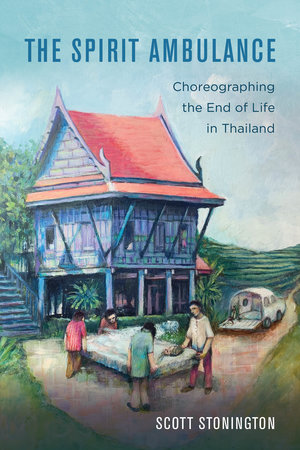This post is part of our #RaisingOurVoices2020 blog series. Learn more at our American Anthropological Association virtual exhibit.
When physician-anthropologist Scott Stonington set out to study end-of-life care in Thailand, he had no idea that his journey would take him so far from his work as a physician in the U.S., or that the experience would help him transform the practice of medicine at home.
In this Author Spotlight, we learn about Dr. Stonington’s book The Spirit Ambulance: Choreographing the End of Life in Thailand, and its portrayal of the tensions between local context and the universal human experience of dying.
UC Press: Your new book The Spirit Ambulance presents stories of families attempting to choreograph good deaths for older people in Thailand. Could you tell us about the phrase that animates the book, “the spirit ambulance?”
Stonington: The “spirit ambulance” is a rush to get elders home from the intensive care unit so that they do not end up lost in the hospital as ghosts. It’s the result of a tension between high-tech hospital medicine and the metaphysics of the human body and spirit.
Children in Thailand owe their parents a debt of life for having been given a body at birth. For some, the best place to pay that debt has become the high-tech hospital. However, it is important to die at home because hospitals are seen by many to be haunted or at least devoid of positive metaphysical effects from ceremonies. The tension between these two pressures leads many families to push intensive care to the last minute and then rush elders home, sometimes using makeshift life-support machines to keep their spirit attached to their body until arrival.
UC Press: One of the themes of the book is the question of how to think about the universal and the particular when it comes to core human experiences such as birth, aging and death. Could you share some of your takeaways, and how to conceptualize dying in our contemporary world?
Stonington: We are often accustomed to thinking about globalization as flows of ideas from one part of the world that land somewhere and dominate or erase what is there. The Spirit Ambulance, however, is about medical science being built seamlessly into a preexisting framework. Cutting-edge technologies are used simultaneously for saving lives and paying back the debt of life, for physics and metaphysics. The takeaway is that high-tech medicine is an increasing part of dying everywhere, but it is being used in specific ways in each place.
UC Press: At the end of the book, you talk about your experiences in Thailand having changed how you practice medicine in the US. Could you explain what you mean?
Stonington: There are so many aspects of death and dying that are the same in both places: that some people want to die at home instead of in the hospital, that they are working out old spiritual debts at the bedside, and that choreographing a good death requires timing and improvisation.
But it was helpful to learn a vocabulary in Thailand for talking about these things. In the U.S., they seemed to be operating without a clear way to name these aspects and incorporate them into decision-making. Although the book is about Thailand, my hope is also to give readers a clearer conceptual vocabulary to make choreographing the end of life easier wherever they happen to be.
UC Press: This has been a medically very dramatic year with COVID at the front of everyone’s lives. Could you share some of your experiences this year providing care and how your approach may have been impacted by your research?
Stonington: I’ve been practicing primary care and hospital medicine throughout the COVID crisis, and have also been interviewing clinicians working in hospitals during extreme surges. There are so many ideas from The Spirit Ambulance that have helped me make sense of what is going on. Perhaps the most surprising for me have been the idea of haunting, designed to help conceptualize the fearsome, invisible and inchoate contagions that inhabit physical spaces where people attempt to choreograph good deaths. I think that at the bedside, we all imagining coronavirus in the air. It has helped to name the virus explicitly as a character in the scene rather than pretend that it isn’t there.

